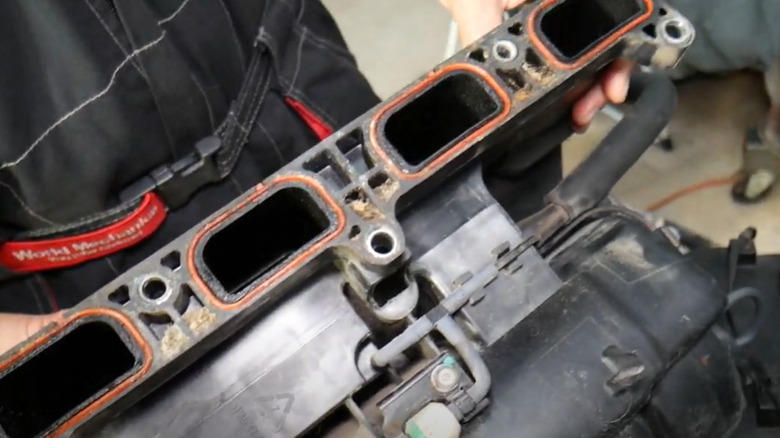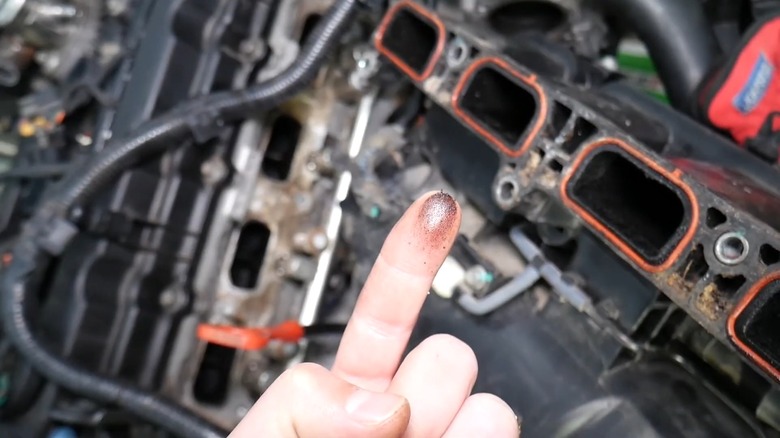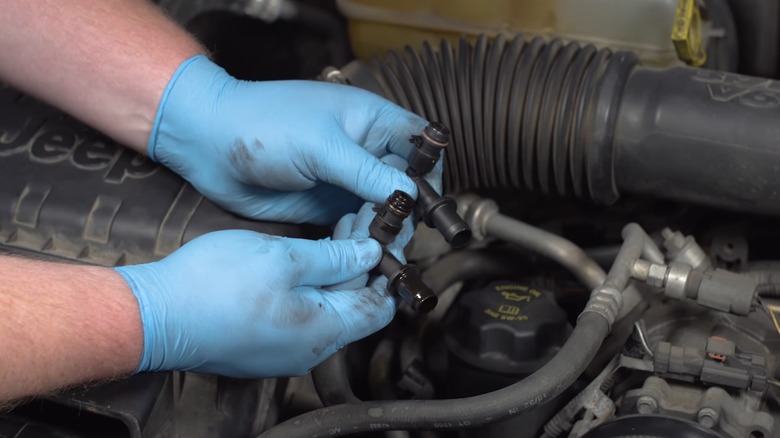Find Oil In Your Intake Manifold? This May Be What's Going On
Whether it's a puddle under your car or a grimy mess inside your engine bay, finding engine oil where it's not supposed to be is never an enjoyable experience. Normally, oil remains contained within the engine and oil pan or sump. However, oil leaks are a relatively common problem that many drivers experience at one point or another. The tricky thing is that leaks can appear due to various reasons and frequently require expert attention in order to diagnose the source of the problem. Worse still, your car can lose oil or dump oil without causing a noticeable leak. If that occurs, your engine oil pressure may drop, causing various issues like overheating or internal damage.
As mentioned, it's not always apparent when your car has a problem like this, until you discover oil residue somewhere, like the intake manifold. While a small amount of oil in the intake manifold can be normal, an excessive amount is not normal and should be a cause for concern. Unfortunately, there are a few different issues that can cause oil to get into your intake manifold. Luckily, though, we're here to shed some light on those issues. From common problems like PCV system malfunctions to things like piston ring wear and engine sludge, here are the most likely causes of oil in your intake manifold and some of the potential fixes.
A handful of issues can cause oil to get into your intake manifold
As covered briefly above, a small amount of oil in the intake manifold can be nothing out of the ordinary. However, if there's a large amount of oil pooling in the manifold, it's usually an indication that something is wrong. One of the most common causes of oil getting into the intake manifold, or another part of the air intake system like the engine air filter or intake tubing, is a damaged positive crankcase ventilation (PCV) system. During standard operation, it's normal for small amounts of fuel or blow by to slip into the crankcase. The PCV system is designed to vent these fuel vapors out of the crankcase and back into the combustion chambers. However, if this system becomes damaged or clogged or the PCV valve itself fails, it can allow oil to escape the engine and find its way into the intake manifold or another part of the air intake system.
Besides a damaged PCV system, a few other issues can cause oil to get into your intake manifold. Another relatively common issue is worn piston rings or damaged cylinder walls. Piston rings function like seals in your engine's cylinders and are designed to prevent gas from escaping the combustion chambers while also allowing the pistons to collect a layer of oil for lubrication. When these devices wear out or experience damage, the amount of fuel or blow by entering the crankcase can increase, potentially causing oil to build in the intake system. Other potential causes of an oil buildup in your intake manifold include an engine sludge problem, worn-out seals and gaskets, as well as malfunctioning turbocharger or supercharger.
What are the potential fixes for oil in your intake manifold?
If you discover large amounts of oil in your car's intake manifold, you should address the issue as quickly as possible. Fortunately, despite the serious nature of this problem, not all of the potential fixes are extremely pricey, and some of them can even make great DIY projects. As mentioned, the most common cause of an oil buildup in your intake manifold is a damaged PCV system, frequently translating to a worn-out PCV valve.
If you're into DIY auto jobs, replacing the PCV valve on your own can be a great way to save some cash. The process is relatively straightforward and doesn't require access to expensive or specialized tools. Depending on your car, a new PCV valve is fairly inexpensive and should cost between $10 and $40. If you perform the replacement at home, you shouldn't have to pay for anything other than the new part. However, if you visit a repair shop, you'll also have to pay for the mechanic's labor, which can add another $50 to $75 depending on your area.
If your vehicle has oil in the intake manifold and the problem is not the result of a bad PCV valve, the fixes can vary. Unless you're an experienced home mechanic, you may want to consider getting a professional inspection to pinpoint the exact cause of the issue in order to save time. Replacing seals and gaskets can be relatively inexpensive depending on the vehicle, and this fix could be another one worth trying at home. On the other hand, getting rid of engine sludge, replacing worn-out piston rings, and repairing forced induction systems, like a supercharger or turbocharger, can be trickier and may require professional attention.


